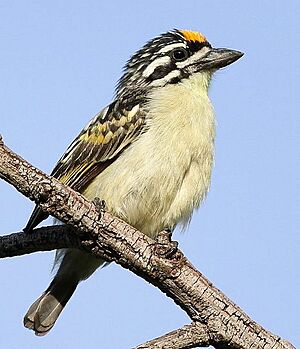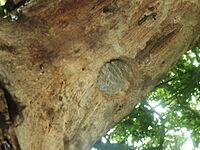Yellow-fronted tinkerbird facts for kids
Quick facts for kids Yellow-fronted tinkerbird |
|
|---|---|
 |
|
| Conservation status | |
| Scientific classification | |
| Genus: |
Pogoniulus
|
| Species: |
chrysoconus
|
| Subspecies | |
|
|
The yellow-fronted tinkerbird (Pogoniulus chrysoconus) is a small, colorful bird. It belongs to the family Lybiidae, which are known as barbets. These birds have special bristles around their beaks. You can find them in tropical areas all over the world.
Contents
What is a Yellow-Fronted Tinkerbird?
This little bird is sometimes called the yellow-fronted tinker barbet. It looks a bit like the red-fronted tinkerbird, which lives further south. Tinkerbirds are a type of barbet. They are not true passerine birds, but they are close.
Different Types of Yellow-Fronted Tinkerbirds
There are a few different kinds, or subspecies, of the yellow-fronted tinkerbird. They can look a little different in size and the color of their feathers. Some of these types include:
- P. c. chrysoconus
- P. c. extoni (found in southern Africa)
- P. c. xanthostictus
Other types are also recognized, depending on where they live in Africa.
Where Do Yellow-Fronted Tinkerbirds Live?
The yellow-fronted tinkerbird lives in many parts of Africa, south of the Sahara Desert. It is a common bird in these areas. You can often find it in open or thick woodlands and bushy areas. They like places with water nearby, like along rivers. However, they are not often seen in very dry savannas.
What Do Yellow-Fronted Tinkerbirds Look Like?
This bird is about 11 cm (4.3 in) long. It has a plump body, a short neck, a big head, and a short tail. The top part of its body is black with bright yellow and white stripes. Its head has a cool black and white pattern. It also has a bright yellow spot on its forehead. The bottom part of its body and its rump are a bright lemon yellow.
Both male and female tinkerbirds look very similar. Young birds, however, have a dark head. They do not have the distinct yellow spot that adult birds have.
How Do Yellow-Fronted Tinkerbirds Reproduce?
Yellow-fronted tinkerbirds make their nests in holes they dig in dead tree branches. These nests are usually about 2 to 5 meters (6 to 16 feet) above the ground. The female bird lays 2 to 3 dull white eggs. She places them on a bed of wood chips at the bottom of the nest hole.
Both parents help to raise the young birds. The baby birds call loudly and often from the nest. They are fed a mix of fruit and insects. Nests usually do not last for more than one season. Sometimes, larger types of barbets might even take over their nests.
What Do Yellow-Fronted Tinkerbirds Sound Like?
The yellow-fronted tinkerbird has a very fast call. It sounds like a quick tink-tink-tink-tink. They can repeat this sound about 100 times every minute!
Many barbets like to sit out in the open when they sing. But the smaller tinkerbirds are different. They usually sing from hidden spots in the trees. This means you are much more likely to hear them than to see them.
What Do Yellow-Fronted Tinkerbirds Eat?
The yellow-fronted tinkerbird eats both insects and fruit. They especially like to eat mistletoe fruits. These fruits are from plants like Tapinanthus and Viscum species. The tinkerbirds swallow the whole fruit.
Mistletoe seeds are very sticky. After eating the fruit, the birds spit out the seeds. They then wipe the sticky seeds off on nearby branches. This helps the mistletoe plants spread to new places. In fact, yellow-fronted tinkerbirds are very important for spreading mistletoe plants across the areas where they live.



